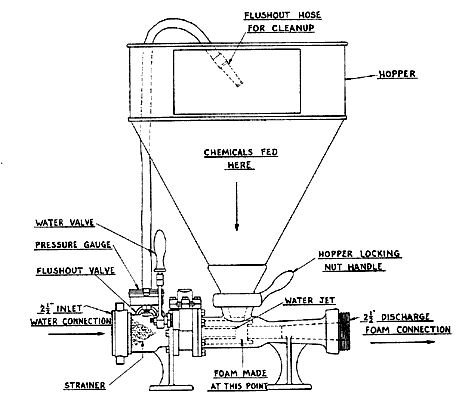| HOME |
| ABOUT US |
| PARTICIPATE |
| COLLECTIONS |
| DC EQUIPMENT MUSEUM |
| SHIP & SUBMARINE MUSEUM |
| WW II DAMAMGE REPORTS |
| SHIPBOARD CASUALTIES |

DC Museum-DC Equipment-Firefighting Equipment
|
|
The foamite generator, Model 15NC, was a dry-chemical
continuous foam generator. Portable or installed, it was used
onboard U.S. Naval ships for firefighting topside fuel and oil
fires on flight decks and in hangar bays during WWII and through
the early 1950s, when they were eventually replaced on surface
ships by the duplex pressure proportioner and later the water
motor proportioner, both mechanical foam apparatus systems. The foamite generator unit was 26 15/16 inches high by 18 ¾ inches wide and weighed 39 pounds with the hopper adapters, cover and brass pressure gauge. The unit was constructed from .125 inch galvanized iron; the base and top were cast bronze. The 2-inch bronze inlet required a 1 ½- to 2-inch iron pipe size (IPS) reducer, and the foam discharge hose connection was 2 ½-inch national standard thread (NST), 7.5 threads per inch (TPI) bronze. The chemicals used with the foamite generator consisted of aluminum sulfate, bicarbonate of soda and a stabilizing solution which produced a thick chemical foam blanket composed of water-film globules-filled carbon dioxide. When in a ready condition, which included a charge that could produce 300-500 gallons of foam, it could provide a delivery rate of 100 gpm through 50, 75 or 100 feet of 2 ½-inch fire hose using a plain 1 ¾-inch foam nozzle. It operated satisfactorily as long as the inlet pressure was maintained between 50 to 100 psi and the unit was refilled with a new foam charge every 30 seconds. When involved in extended firefighting operations, two personnel were required to operate the unit, with five additional personnel required to man each hose. Two other personnel broke out spare charges from stowage to have them at the ready. After use, the unit had to be flushed with fresh water and wiped down. Particular attention had to be given to ensure the check valve housing was clean and free from hardened deposits that caused the unit to clog up. At least ten spare Type III charges were stored near the unit stowage location for immediate access. Additional charges were stored in the island and in repair locker 1 Baker (later Bravo) in the hangar bay. |
